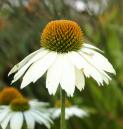By E. G. BAKER
Read at an Evening Meeting of the Pharmaceutical Society, Wednesday, December 8 1886.
The following are a few notes on a sample of galbanum collected by Dr. Aitchison, Surgeon-Major, in Afghanistan, and brought back by him, together with the plant from which it was collected. The plant has been identified by Mr. Hemsley, of the Kew Herbarium, as Ferula galbaniflua, Boiss. et Buhse.
The gum-resin consisted of agglutinated team of a white or reddish-brown color, usually compact and hard, but softening if held in the hand.
When broken it presents a dull white waxy fracture resembling ordinary ammoniacum, in fact, judging from external appearances, it might easily be mistaken for a sample of that drug.
Its odor is peculiar, but not unpleasant. Mixed with the gum-resin, portion, of the stem from which it was obtained were found.
From the sample handed over to me for examination, a portion was selected fairly representative of the whole; this was powdered and sifted through muslin, and then treated with the following solvents:
Petroleum Ether.— Of the sifted gum-resin I took 5 grams, and treated it with 50 cc. of petroleum ether-allowing the mixture to remain in a suitable vessel for several days, during which time it was frequently agitated. I then decanted the fluid portion into a tared dish, rinsed the vessel out with more petroleum ether, and evaporated the whole of it as recommended by Dragendorff, in a current of dry air, the air being dried by passing through sulphuric acid and over chloride of calcium.
The petroleum ether extracted .1254 gram; adding to this .03 as the loss during evaporation would give .1554 gram or 3.1080 per cent.
Ether.— The portion of the 5 grams remaining from the petroleum ether extraction was next treated with ether and allowed to remain as before. This was decanted and evaporated over a water-bath. It was only after several days that the weight was found to be constant, at the latter stages of the operation the evaporation taking place slowly. The matter extracted by ether was found to weigh 3.060, grams. This was then treated with alcohol, in which it was almost wholly soluble, .226 gram of the 3.060 grams remaining undissolved.
The alcoholic extractive was evaporated, and consisted of a brittle resin, the melting point of which, when taken over mercury, was found to be 57° C. The resin was soluble in soda, from which it was reprecipitated by an acid.
Alcohol.— The portion of the gum-resin remaining from the ether extraction was next treated with alcohol. The resulting fluid was evaporated over a water-bath. The residue weighed .3788 gram.
Water.— The portion of the gum-resin remaining from the alcohol extraction was next treated with distilled water. The filtrate evaporated over a water-bath yielded .8514 gram of residue.
The latter was again treated with water, and various reagents applied. With ammonium oxalate and subacetate of lead the solution of gum gave copious precipitates, but none with acetate of lead or borax.
Insoluble Matter.— The portion of the gum-resin insoluble in petroleum ether, ether, alcohol and water, was found to weigh .5280 gram.
Volatile Oil and Moisture.—.7876 gram of the powdered gum-resin above referred to was next taken; this, after several days' evaporation, lost .042 gram, which would represent 5.332 per cent., and would be the volatile oil and moisture.
Ash.— In order to determine the ash 1.5792 gram of the gum-resin was taken and burnt in a furnace, The ash, which was white, weighed .039 gram; this would represent 2.463 per cent.
Upon examination the ash was found to consist of carbonates of calcium and sodium, sulphates and phosphates being absent.
When examined by the spectroscope the sodium and calcium bands were plainly visible. There was also a band in the red to the right of the calcium bands, which might possibly be strontium. The quantity present was not sufficient for a determination of its position.
Action of Gum-Resin with various Reagents.— Sulphuric acid turned the gum-resin dark brown. Hydrochloric acid gave no well-marked action in the cold, but when a portion of the gum-resin was boiled with this acid a dirty red color was obtained, which underwent no change on the addition of alcohol.
A small portion of the gum-resin was boiled with water, and when cold, ammonia added; a very slight blue fluorescence was visible, which indicates the presence of umbelliferon C9H6O3. To confirm the result a portion of the gum resin was heated for some time with hydrochloric acid at 100° C.; this, when cold, was put into a glass separator with some chloroform, and after agitation, the chloroformic layer drawn and evaporated. No crystals were visible, but when the evaporated chloroformic layer was extracted with water and ammonia added, a decided blue fluorescence was seen.
I then fused a portion of the gum resin with nitre, extracted the mass with water, and added barium chloride; this gave a precipitate wholly soluble in acid, indicating the absence of sulphur in the drug.
The analysis is then as follows:
| Grams | Percent | |
| Volatile oil | .1554 | 3.108 |
| Ether extractive (resin) | 3.0600 | 61.200 |
| Alcohol extractive (resin) | .3788 | 7.576 |
| Water extractive, gum | .8514 | 17.028 |
| Insoluble matter | .5280 | 10.560 |
| 4.9736 |
The foregoing experiments were made in the Pharmaceutical Society's Laboratory, by permission of Professor Attfield.—Phar. Jour. and Trans., Dec. 11, 1886, p. 146.
The American Journal of Pharmacy, Vol. 59, 1887, was edited by John M. Maisch.

